Taking a divot after you hit an iron shot is a good thing. A divot is physical proof that you have hit down through the ball – which is exactly what you should be trying to do while hitting an iron shot. Hitting down on the ball allows you to impart backspin on the shot, which will help the ball climb high into the air. Many amateur golfers never master the skill of hitting down on their iron shots, and they struggle to gain consistency for that reason. If you wish to hit a high percentage of greens in regulation, you will take the time to learn how to hit down on the ball.
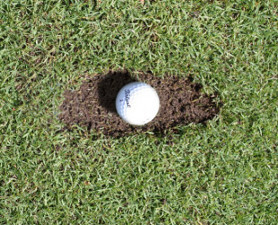
Of course, there is the possibility of having too much of a good thing. If you hit down too steeply on the ball, you won't achieve the results you desire. The best way to determine if you are hitting down to steep is to check the shape and depth of your divots. An ideal divot is a shallow strip of turf, but you may find that you are taking large chunks out of the fairway when your swing gets steep. If you are pulling up a big chunk of dirt along with the grass that makes up your divot, there is a good chance that you need to work on shallowing out your swing.
Divots are a part of golf. When you strike the ball and take a chunk out of the turf with your club, that is called a divot. While some golfers see a big piece of turf go flying and they think that something has gone wrong, divots can actually be a sign that you have made an excellent swing. The key is to make your divot the right size and take it out of the right spot in the ground, as compared to the ball.
To take any confusion out of this topic, we are going to dedicate the following article to the topic of divots. While it might seem like there isn’t that much to say about this single subject, taking a closer look reveals that divots can tell you a lot about your game – and they can actually help you make improvements, when you know how to analyze them properly. We will discuss a range of issues related to divots, and we hope you’ll leave feeling fully educated on this surprisingly important golf topic.
All of the content below is based on a right-handed golfer. If you happen to play left-handed, please take a moment to reverse the directions as necessary.
— The Value of Taking a Divot
If you currently think of a divot as a sign that you did something wrong in your swing, it’s time to turn that thinking around. While a divot could be a bad sign, it can also be an indication that you made a great move through the ball at impact. It’s all about the details – you’ll need to learn how to read your divots to determine if they are saying good or bad things about your technique.
We’ll get into the science of analyzing your divots in the next section. For now, let’s talk about why taking a divot can be valuable and what it can do for your game.
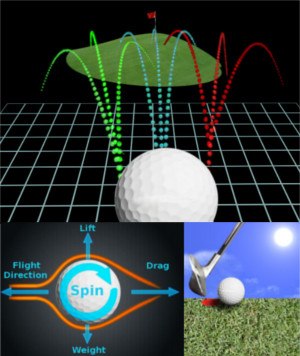
- Add distance. That’s right – when you take a divot with one of your irons properly, you can actually add distance to your shots. Hitting down through the ball is going to lead to a divot, and it is also going to allow you to compress the ball firmly against the face of the club. It’s that compression that will help you gain distance. One of the nice things about hitting down through the ball and compressing it at impact is that your contact with the ball will feel great when you strike it just right. This is a feeling that keeps golfers coming back time and time again. A well-executed downward strike with an iron is one of unforgettable experiences you can have on the course, so working toward it on the driving range will be worth the effort.
| GOLF FIXES BY PGA PROS |
|---|
| Divot to Right Field | Video | Article |
| How to Hit the Ball from a Divot | Video | Article |
| Are Divots Pointing Left A Good Thing In Golf | Video | Article |
| Causes Of Why My Golf Divots May Point Left | Video | Article |
| How To Adjust The Golf Swing For Toe And Heel Divots | Video | Article |
| How To Cure Toe And Heel Divots During The Golf Swing | Video | Article |
| Strike Down to Escape Hardpan and Divots | Video | Article |
| How To Fix The Problem Of Your Divots Being Too Deep Golf Tip | Video | Article |
| How To Fix The Problem Of Your Golf Divots Being Too Deep | Video | Article |
| All About Divots A to Z Lesson | Video | Article |
| Why Are My Divots Pointing Left After A Golf Shot | Video | Article |
| How To Self Correct Golf Divots Pointing Too Far Left | Video | Article |
| Divots Pointing Left Of The Target Line Golf Tip | Video | Article |
| Likely Causes Of Your Golf Divots Being Too Deep | Video | Article |
| Cause And Cure Of Deep Toe Or Heel Golf Divots Golf Tip | Video | Article |
| Cause Of Unequal Toe And Heel Divots During The Golf Swing | Video | Article |
| Curing Heel Deep Divots And Strikes In The Golf Swing | Video | Article |
| LESSONS |
|---|
| Evaluating Your Current Golf Divot | Video | Article |
| In Swing Tips For Taking A Golf Divot | Video | Article |
| Should I Hit The Ground And Take A Divot When Hitting Golf Iron Shots | Video | Article |
| Taking A Divot In The Golf Short Game | Video | Article |
| What Divot Depth Will Tell You About The Golf Swing | Video | Article |
| What Divot Shape Can Tell You About The Golf Swing | Video | Article |
| Correct Golf Swing, Sweeping Or Take A Divot | Video | Article |
| What Is Your Golf Divot Trying To Tell You | Video | Article |
| The Benefits Of Taking A Divot | Video | Article |
| Taking A Divot After The Ball Explained | Video | Article |
| Which is Best Sweeping Swing or Take a Divot | Video | Article |
| A Sweeping Golf Swing Or Take A Divot | Video | Article |
| Different Golf Divot Types | Video | Article |
| Evaluating Your Current Golf Divot Making Mechanics | Video | Article |
| Other Causes Of Deep Golf Divots | Video | Article |
| Divots Provide Valuable Swing Info | Video | Article |
| Divots Exit Right Will Solve Slice Fault | Video | Article |
| Can Senior Hybrid Golf Clubs Be Played Out Of Divots? | Video | Article |
| Evaluating Your Current Current Swing Path With Divots | Video | Article |
| Evaluating Your Golf Divots | Video | Article |
| Golf Short Game Divots | Video | Article |
| What can you tell from your divots | Video | Article |
| Hitting Toe Or Heel Divots During The Golf Swing | Video | Article |
| Check Your Golf Divots For Swing Information Feedback | Video | Article |
| What Fat Golf Divots Show | Video | Article |
| Hybrid Golf Clubs, Good For Sweeping Swing To Help Avoiding Taking Divots | Video | Article |
| Ladies Hybrid Golf Clubs A Good Choice Out Of Divots | Video | Article |
| How To Evaluate Where My Divots Are Pointing After A Golf Shot | Video | Article |
| What The Direction Of Golf Divots Will Tell You | Video | Article |
| Why Do You Want Golf Divots And What They Show | Video | Article |
| Swing Thoughts For Divots And Sweeping | Video | Article |
| Why and How you Should Look at Your Divots | Video | Article |
| Look At Depth And Direction Of Divots For Golf Swing Information | Video | Article |
| Look at your Divots to Fix your Golf Shots | Video | Article |
| Deep Divots Can Be A Problem In The Golf Short Game Too | Video | Article |
| Hybrid Golf Clubs, A Good Choice Out of Divots? | Video | Article |
| PRACTICE DRILLS |
|---|
| Fat Golf Shot Drill: Mark ball position with tee to see divot | Video | Article |
| Check Your Divots To Help Correct Pushed Swing | Video | Article |
| Cure Swing Fault With Divots To Right Field | Video | Article |
| Look at your Divots for Feedback Swing Cures | Video | Article |
| A Great Drill To Take Golf Divots | Video | Article |
| GOLF QUESTIONS |
|---|
| If My Golf Ball Lands In A Divot How Can I Play It? | Video | Article |
| Can I Use The Divot To Tell Me Anything About My Golf Swing? | Video | Article |
| Why Are Hybrid Golf Clubs A Good Choice When My Ball Is In A Divot | Video | Article |
| How do you hit a shot from a fairway divot? | Video | Article |
| What Can You Tell From Your Divots On The Golf Course | Video | Article |
| What Does It Mean If My Divots Point to the Left? | Video | Article |
| What Should My Golf Divots Look Like With A Short Iron? | Video | Article |
- Add backspin. Have you ever wondered how professional golfers are able to stop their wedge and short iron shots so quickly when they land on the green? Sometimes, those shots will even have so much stopping power that they spin back toward the player after bouncing once or twice. While there are a few different factors that come into play here, one of the biggest keys is hitting down through the ball and producing a divot. By hitting down, you’ll be able to use the friction created between the ball and the club face to produce a significant amount of backspin. It also helps to have a quality golf ball that is capable of spinning at a high rate, and wedges that are clean and in good condition. Once you add spin to your wedge shots, you’ll be amazed at how aggressive you can be with those approaches, knowing that the ball is going to stop quickly after it lands.
- Deal with various lies. If you are always trying to pick the ball off the top of the turf, you might have reasonable success when your lie is perfect. However, once you find a situation where your lie isn’t quite ideal – maybe the ball is sitting down a bit, or maybe you are just off the fairway in the light rough – things will change for the worse. If you are in the habit of hitting down through your shots and taking a divot, you will be better prepared to deal with these kinds of situations. Bad lies are still challenging for a player who takes a divot, of course, but you’ll have more options to deal with a bad lie when you know how to hit down through the ball properly. If you are currently a player who runs into big trouble every time the ball isn’t perfectly perched on the grass, consider working on your ability to hit down as a way to improve in this part of the game.
There are plenty of benefits associated with taking a proper divot. You aren’t going to want to take a divot on all of your shots, of course – for instance, you don’t want to take a divot when hitting a driver from the tee. As long as you are taking your divots in the right manner, and at the right times, they can be a big boost to your overall level of play.
— How to Analyze Your Divots
There is a lot to know about divots, and if you aren’t informed, you are missing out on a potential wealth of information. This information can help you not only during a round, but also after the round when you head back to the range to work on any issues in your swing. If you are willing to put in just a bit of effort to get educated, and then are willing to pay attention to your divots from shot to shot, it’s amazing what you can learn.
We may not be able to provide you with a complete divot education in this section, but we will touch on a few of the key points.
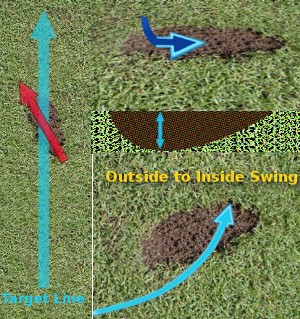
- Starting point. When playing an iron shot from the fairway, you want to strike the ball first before your club heads down into the turf to take a divot. If you hit the grass first instead of the ball, you will hit the shot fat and the ball will almost certainly come up short of the target. If you hit the shot just slightly fat, you might only lose a few yards. Or, if you hit way behind the ball, it’s possible to miss completely as the club could bounce back up after the divot and go over the ball on the way through. When you badly miss-hit a shot, you won’t need to look at the divot to learn anything – you’ll already know that it went wrong based only on the feeling of the club hitting the turf and the outcome of the shot. However, for smaller mistakes, you might want to check the starting point of the divot to make sure it is just a bit in front of where the ball was resting.
- Check the direction. One of the best ways to evaluate your swing after you take a divot is the direction that the hole in the ground is pointing. It’s best to look at this from behind where your ball was, looking out toward the target. You know where you meant to aim for the shot, so you can quickly compare how your divot looks to the target you had in mind for the that shot. Did you swing directly down the line, toward the target? Or is your divot pointing out to the left or right of where you intended to swing? This is a great way to get visual feedback on a swing you have just made, as it can tell you a lot about any issues that might be present in your technique. Later, we’ll talk about how you can make some corrections to improve the direction of your divots in the future.
- Evaluate the depth. The depth of your divots can tell you a lot about the angle of attack you used in your downswing. If you take a deep divot, you’ll know that you swung down aggressively into the ball – with a shallow divot, you were working toward impact on a flatter angle. Generally speaking, you will take deeper divots with your short irons than your long irons, but none of your divots should be so deep that it feels like your club is getting stuck down in the turf. Most players are served well by a moderate divot that goes maybe an inch or so down, but the ideal divot depth will vary from player to player. Also, keep in mind that course conditions will alter how the turf comes out of the ground. When the course is soft, deeper and larger divots are likely, even if your swing isn’t particularly steep. On the other end of the spectrum, you might find it hard to take much of a divot at all on a firm course, as the turf will simply cause the club to bounce right back up after impact.
- Entry angle is telling. This point is a little trickier than the first two, but once you understand how to see it you’ll learn a lot about your swing (and maybe even your equipment). What you are hoping to see at the back of your divot is a clean entry into the turf where the leading edge of the club sliced the grass evenly from side o side. If the divot is angled at the back, meaning one side of the divot starts before the other side, it means that either the toe or heel of the club is entering the ground first. This could be indicative of a swing mistake, or it could signal that the lie angle of your club is not a good fit for your needs. If you seem to be producing a lot of uneven divots at the entry point, consider working with a professional club fitter in your area to evaluate your equipment and determine if any changes will be necessary.
Reading your divots is part science, part art. To get started, just make a habit of looking at your divot after each shot. Even if you don’t know exactly what you are looking for at first, make it a point to check out the divot while you are replacing the turf or filling the hole with sand. Over time, you’ll get used to the patterns you see and will be able to notice when something looks different than normal.
— Adjusting Your Divot Pattern
It wouldn’t do much good to pay attention to your divot pattern if you don’t intend to work on improving your technique once you spot problems. The whole point of monitoring how your divots look is so you can take that information and use it to make yourself a better golfer moving forward. In this section, we’d like to point out a few ways you may be able to improve based on the issues you find with your divots.
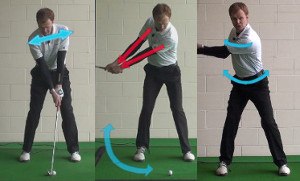
- Improve balance to correct entry point. If you are having trouble starting your divots at the right point on the ground, it’s likely that this issue is related to your balance. Countless players struggle to stay balanced while they swing, either because of a technical flaw or simply because they swing too hard to maintain control. Whatever the reason, work on improving your balance from start to finish and you should find that the location of the bottom of your swing becomes more consistent. A good way to check your balance is to evaluate yourself both at address and when holding the finish. If you are nicely balanced at both of these checkpoints, it’s far more likely that what happens in the middle of the swing will be successful.
- Check alignment. When your divots seem to be pointing in the wrong direction, you should check your alignment before you start thinking about any changes to your swing technique. It’s easy to think that your swing mechanics must be to blame for the club heading in the wrong direction, but it might actually be as simple as an alignment mistake at address. Work on your alignment during practice by placing a stick or extra club along your foot line to serve as a visual aid for where you want to aim. With enough repeated practice on the range, it should become rather easy to aim yourself properly on the course.
- Straighten out your takeaway. Once you have improved your alignment to the point where you don’t have to worry about it being the cause of your misguided divots, you can then turn your attention to your swing technique. One quick way to send the club off-path during the swing is to make an error in your takeaway. If you take the club back too far to the inside or outside in the first foot of the backswing, you’ll struggle to get it back on path in time to swing through the hitting area properly. To improve your path in the takeaway, take your hands out of the action and focus on using your shoulders to turn away from the target. With quiet hands and a stead turn with your upper body, it should be relatively easy to move the club back in the proper direction.
- Turn, don’t slide. This point goes along with the point above about improving your balance, but we wanted to emphasize it here because it is so important. If you find that you are taking particularly deep divots with your irons, it’s possible that you are sliding to the left in the downswing, rather than rotating properly. While there is bound to be some lateral movement in your downswing, that movement should be a result of your rotation – it should not be an intentional slide to the left. If you slide left, your center of gravity will get too far past the ball, your swing will be quite steep, and you’ll take a huge divot in the end. Learn to turn through the shot instead of sliding on the way down and you will be pleased with the improvement of your ball striking.
It can be hard to make swing improvements on your own. If you have noticed something about your divot pattern that needs to be corrected, but you can’t quite figure out how to make it happen, consider taking a lesson from a local teaching pro. Golf lessons are relatively affordable and can make a world of difference in your game. Even taking just one lesson could leave you with enough ideas to work on to keep you busy at the range for months to come.
— Short Game Divots
Did you know that divots are a factor in the short game as well as the long game? While you typically won’t take as much of a divot on your short shots as you will with a full swing, it’s still important to think about what divots mean in this area of play. Let’s cover a few points on this topic as we wrap up our article.
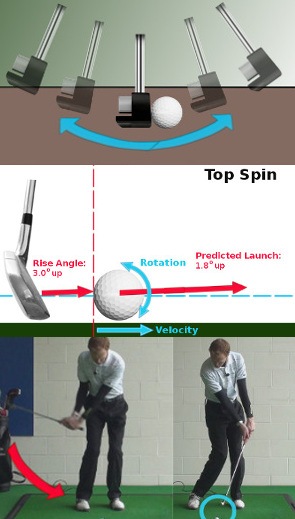
- Never while putting. Simply put, you should not take a divot while putting. The idea with the putter is to roll the ball cleanly across the top of the turf by striking it with a stroke that moves roughly parallel to the ground. If you are swinging your putter down into the turf so steeply that you are taking a divot, something is seriously wrong with your technique. Most likely, you are using too much hand and wrist action during the stroke if divots are a problem on the greens. Quiet your hands and wrists and simply let the putter flow back and through by rocking your shoulders.
- Clip the grass for a standard chip. When hitting a basic chip shot where you expect the ball to land on the green and run out to the hole, you’ll want to just lightly clip the grass as you swing through. You won’t take a big divot on these kinds of shots, but you don’t need to miss the grass entirely, either. Swing down slightly through impact so that you can contact the ball first before brushing the grass with the bottom of your club. Depending on the conditions of the course, you might take a little divot – or you might see no evidence at all that your club even hit the ground. As long as you can feel the club bump into the turf after striking the ball, you should be on the right track.
- Get steep to add spin. Finally, when you want to add a lot of spin to a chip/pitch shot, you can make your swing steeper and hit down through aggressively. This technique will lead to a bigger divot, and this type of shot also comes with some risk. You’ll be swinging rather hard to pinch the ball into the turf and send it up toward the hole on a low trajectory. The idea is that the ball will take one or two bounces before stopping quickly – hopefully near the hole. This can be an effective way to pitch the ball, but only when you have a good lie and enough room to work with for this technique to be effective. Since this is an advanced technique which requires plenty of practice, don’t try it out on the course until you are confident in your ability to make it work.
For something that is so easy to overlook, divots can have a big impact on your performance on the links. Whether you are a player who likes to take a big chunk of turf with every iron shot, or one who likes to pick the ball off the grass while barely leaving a mark, it’s important to think about what your divots mean and what they are telling you about your game. Thank you for taking the time to read this article and we hope you’ll be a better golfer as a result of this discussion. Good luck!






